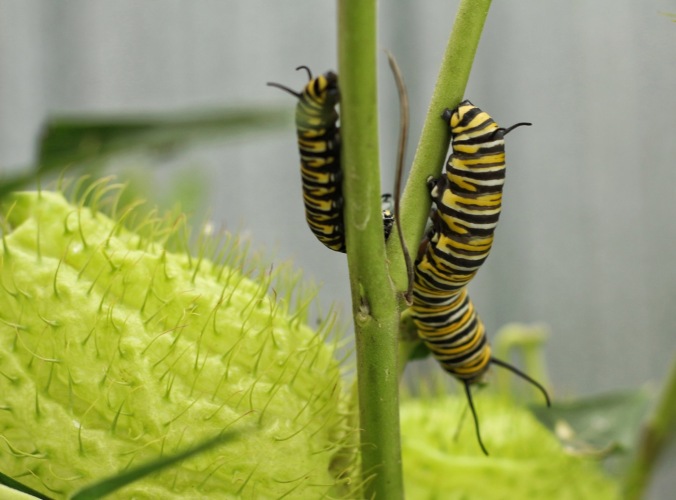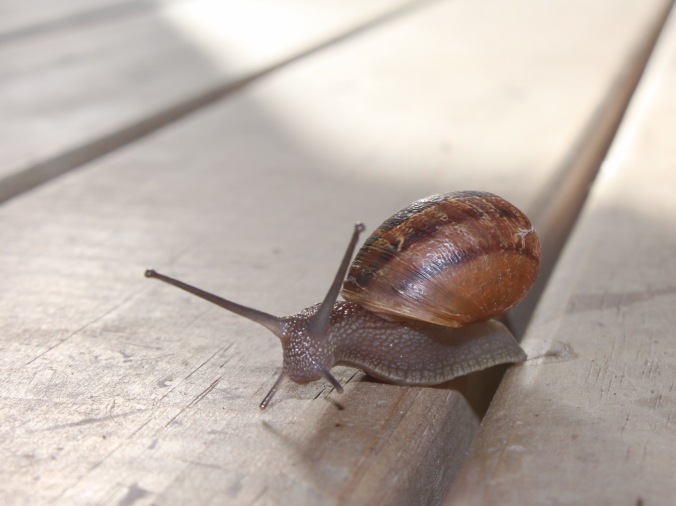“Notice the small things. The rewards are inversely proportional.” — Liz Vassey
In nature, Vassey’s words are particularly true. Whole eco-systems can be compromised by disruption to even the smallest part.
In 1800 Johann Gottlieb Fichte noted that “you could not remove a single grain of sand from its place without thereby … changing something throughout all parts of the immeasurable whole”.
Edward Lorenz later described this phenomenon as the butterfly effect.
Scientists now believe that Earth is experiencing a potentially catastrophic loss of biodiversity — with insect species being especially at risk. (See Science Direct article)
Diminishing numbers of bees and butterflies have caused widespread concern, and gardeners around the world consciously grow plant species to feed and support these creatures.
But, while gardeners may not like them, snails and other less glamorous creatures are necessary too — consuming rotting vegetation and providing food for other species like birds, lizards and mammals.
Starfish are regarded as a “keystone species” in marine ecosystems — but are sensitive to both marine pollution and water temperatures.
The loss of any part of nature’s elegant and beautiful system is a tragedy in itself, but the consequences reach far beyond any single extinction, threatening the whole Earth.
It seems that humans have the power (at least for now) to protect the life-forms that remain (including our own), and reverse some of the damage done. But we’d better be quick.
Posted to Lens Artist’s Photo Challenge | nature







Great set of images and words for the prompt, Su
LikeLiked by 2 people
Thank you Sue.
LikeLiked by 1 person
😊
LikeLiked by 1 person
Wise words, great photos.
LikeLiked by 1 person
Thanks Susan 😀
LikeLike
Lovely photos, Su, that is so true – all life is interdependent.
Leslie
LikeLiked by 2 people
Thanks Leslie 🙏
LikeLiked by 1 person
🙂
LikeLiked by 1 person
What wonderful photos…and the sobering thoughts to go with them, Su. I let some milkweed grow in one of our gardens and we also have a butterfly bush, which brings some lovely insects right outside our window when it’s blooming. We really do need to act quickly, but there are little things that regular people can do as well.
janet
LikeLiked by 2 people
Thanks Janet. I completely agree with you. The “butterfly effect” includes our actions too — every milkweed plant and bee-friendly garden, every time we choose natural over synthetic pest control — baby steps but if enough of us take them …
LikeLiked by 1 person
Which is why, in my opinion, we need to appreciate all of nature that much more. Thanks, Su. 🙂
LikeLiked by 1 person
Thanks Amanda. I agree wholeheartedly.
LikeLiked by 1 person
Bless you for this post, Su. ❤
LikeLiked by 1 person
Thank you so much 🙏
LikeLiked by 1 person
Stunning photography, sobering words.
LikeLiked by 1 person
Thanks Anabel. I sat down to post something completely different, but I guess my subconscious had other ideas.
LikeLiked by 1 person
I loved this cartoon I saw the other day. I hope the link comes through OK. It has been a while since I added one.
LikeLiked by 1 person
Thanks for the link. Loved the cartoon 😀
LikeLike
Fabulous pictures 🙂
LikeLiked by 1 person
We should start tomorrow. Even better, backward in time starting 50 years ago.
LikeLiked by 1 person
If only …
LikeLike
Su, indeed, we need to spread the word of the importance of each creature for the health of the planet. As you know, the monarch’s survival and bees are tenuous, and that scares me. Thanks for advocating on behalf of our better half: Mother Nature.
LikeLiked by 1 person
I read that dung beetles are even more threatened, and they’re not glamorous so it’s harder to get the story out there. But their functions are crucial too.
LikeLike
Love your work, Su. Those images are exquisite.
LikeLiked by 1 person
Thanks so much Tracy
LikeLiked by 1 person
Incredible photography!
LikeLiked by 1 person
Beautiful images, important message Su. Well done
LikeLiked by 1 person
Thank you Tina 🙏
LikeLike
Magnificent close-up shots on the small (big actually) miracles of Nature, Su!
LikeLiked by 1 person
Thanks Peter.
LikeLiked by 1 person
Thank you so much for this post, Su. Not only are your photos beautiful – they hillustrate a most important message.
LikeLiked by 1 person
Thank you. It is heartening that so many people feel,the same way.
LikeLiked by 1 person
Stunning captures, Su: the colours are marvellous! What an incredible way to encounter beauty!
LikeLiked by 1 person
Thank you Ju-Lyn. 🙏
LikeLike
Wonderful, Su. Thank you for posting this message and the gorgeous images.
Deb
LikeLiked by 1 person
Thanks Deb. It sort of wrote itself once I started thinking about it.
LikeLiked by 1 person
A lovely post Su and some really great photos.
LikeLiked by 1 person
Thanks Gavin 😀
LikeLiked by 1 person
Such a good post in regards to nature! So many species are dwindling away. I like your snail photo! http://robertsnapspot.com/2019/02/18/macro-monday-snail-on-stem/
LikeLiked by 1 person
Well done, Su. Let us all work to do what we can to save our planet. I only buy plants that attracts insects for my garden. I do think the awareness is growing – but as you say, we had better be quick in response.
LikeLiked by 1 person
I agree — and desperately hope our efforts are enough.
LikeLike
💚
LikeLiked by 1 person
Pingback: Lens-Artists Photo Challenge #34: Close-Up | Leya
Great photos, the starfish is really something nice to see
LikeLike
I like the quote ‘Notice the small things ….’ and I love how macro photography shows up things we didn’t notice.
LikeLiked by 1 person
Thanks Wendy. I love that too.
LikeLiked by 1 person
Such a wonderful and poignant post, Su! Your words echo my thoughts and feelings regarding this issue perfectly. And your photos are as always just stunning. I’m so I’m love with those bumblebee, snail and starfish shots! I was always quite fond of snails which drove my mother crazy because as a gardener she just hated them. 😂
It’s terrifying how fast so many species are decimated by us humans. I have a feeling there’s not much time left for us to save the planet and ourselves if we don’t change our selfcentered and selfish ways really soon. 😯
LikeLiked by 1 person
Thank you so much my friend. Some days I just despair for our planet. But I guess if those of us who care keep doing what we can, and raising our voices to inform others, maybe we can be the change that is needed.
LikeLiked by 1 person
Thank you for your important post. You touch on events very near and dear to me. I have done posts myself on both the butterfly catastrophe and sea star wasting disease recently on my blog. Get the word out!
LikeLiked by 1 person
Thank you. It is heartening when I realise so many people are writing about environmental problems.
LikeLike